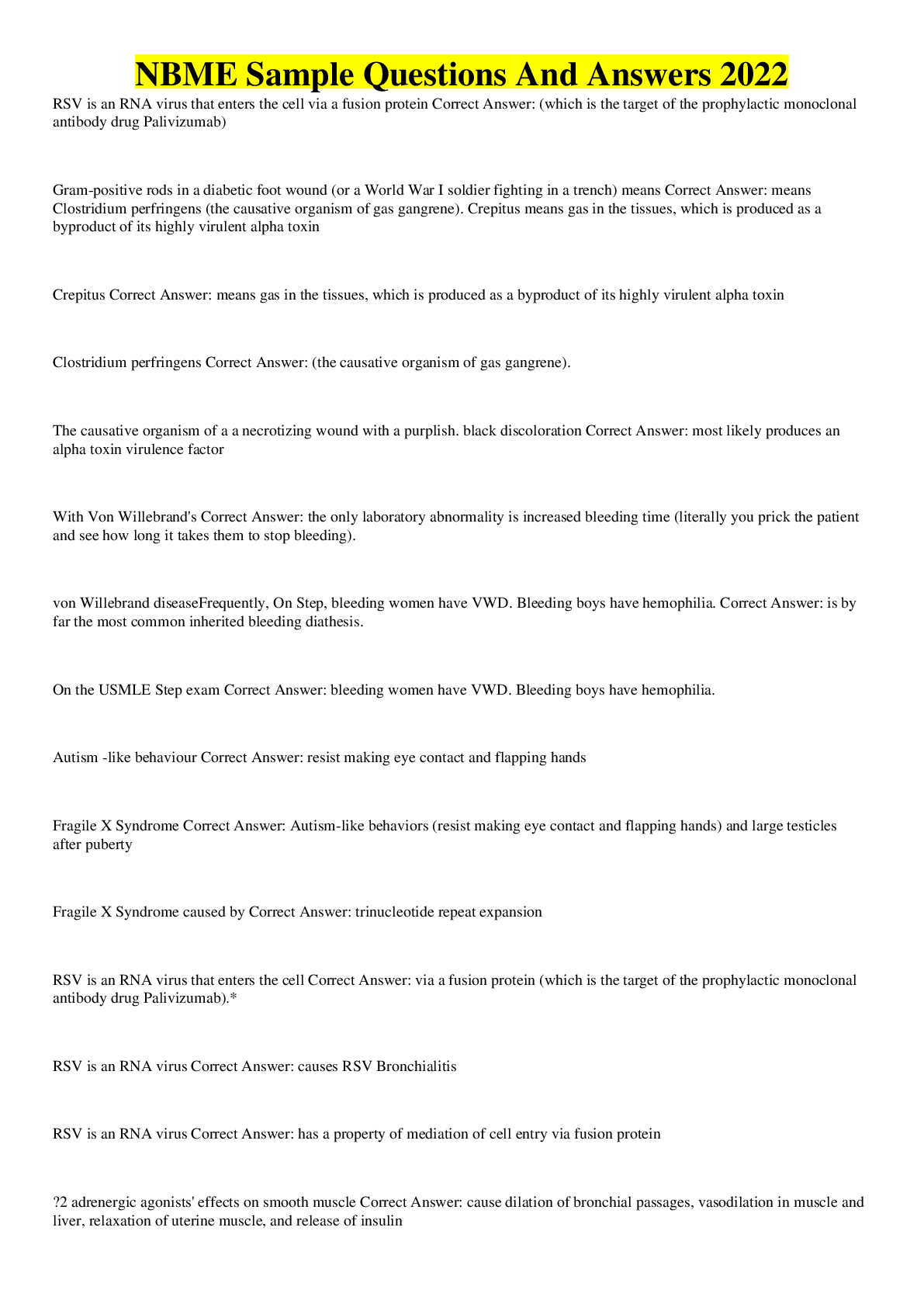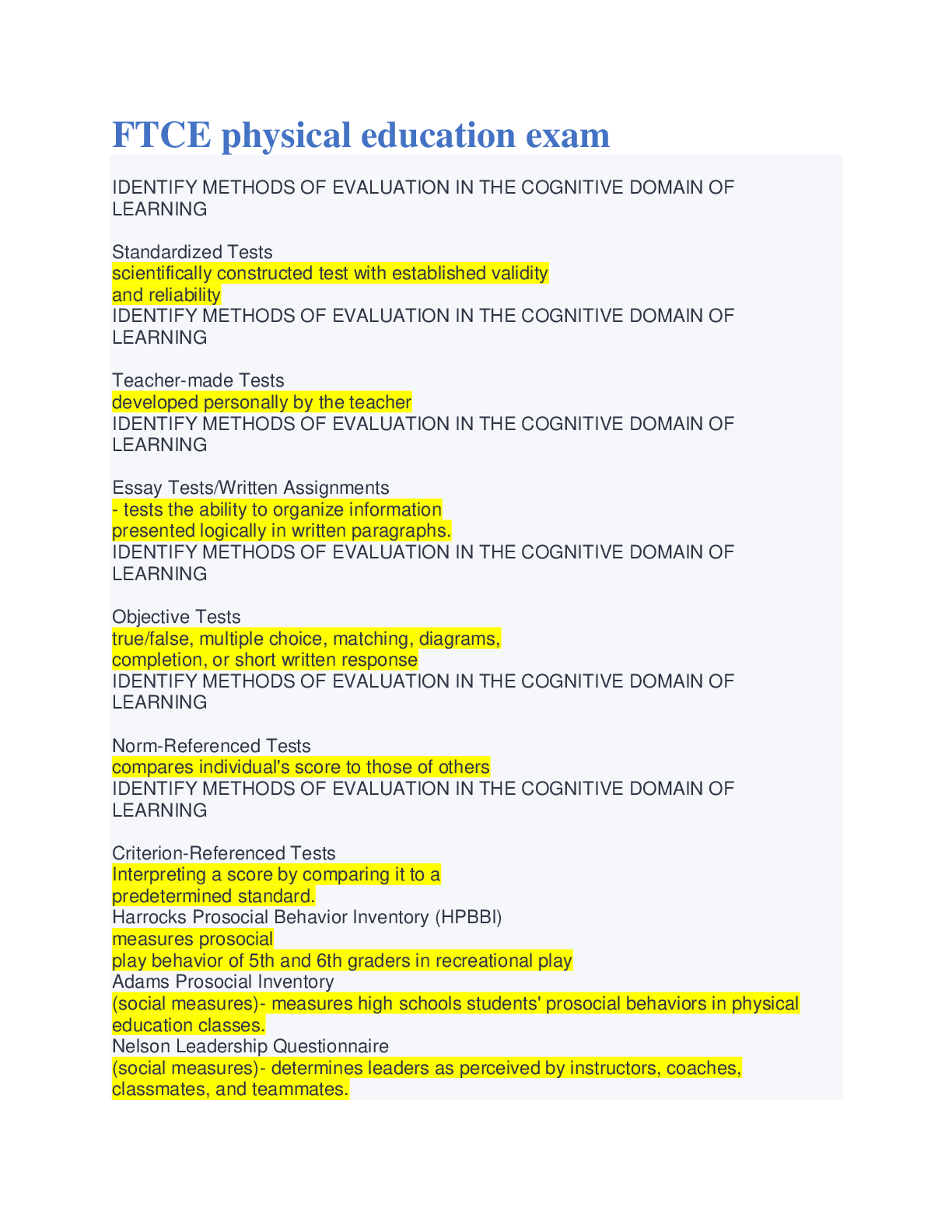Health Care > EXAM > Gizmos; Unit Conversions 2 - Scientific Notation and Significant Digits_2021 Already Graded A (All)
Gizmos; Unit Conversions 2 - Scientific Notation and Significant Digits_2021 Already Graded A
Document Content and Description Below
Student Exploration: Unit Conversions 2 – Scientific Notation and Significant Digits [Note to teachers and students: This lesson is designed to be a follow-up to the Unit Conversions Student Expl... oration sheet. The same Gizmo is used for both activities.] Directions: Follow the instructions to go through the simulation. Respond to the questions and prompts in the orange boxes. Vocabulary: resolution, scientific notation, significant digits Prior Knowledge Questions (Do these BEFORE using the Gizmo.) Philip measures a room using his feet. (His feet are each about a foot long.) He estimates the room measures about ten and a half feet by thirteen and a half feet. He calculates the room’s area to be: 10.5’ × 13.5’ = 141.75 ft2 . 1. Which do you think is the best description of the area of the room? Highlight your choice. A. The room’s area is exactly 141.75 ft2 . B. The room’s area is about 142 ft2 . 2. Explain your choice: I believe that A is a better answer because it is more precise and would be better to use when using the measurement for other purposes Gizmo Warm-up When scientists report a value, they have to take several things into consideration. Sometimes values are very large or small. In this case, scientists can use shorthand called scientific notation to report the value. Scientists also must consider how precise their value is. The precision of a measurement can be shown by the number of significant digits in the value. To begin, check that the Burj Khalifa question is shown. Drag the three tiles shown below to determine the tower’s height in micrometers. The answer is given in scientific notation. 1. The Burj Khalifa is 828,000,000 micrometers tall. How is this value written in scientific notation in the Gizmo™? 8.28*108micrometer 2. In a value, any non-zero digit is considered a significant digit. (Zeroes may or may not be significant.) What is the minimum number of significant digits in 828,000,000? 828 Reproduction for educational use only. Public sharing or posting prohibited. © 2020 ExploreLearning™ All rights reserved This study source was downloaded by 100000844708667 from CourseHero.com on 09-08-2022 17:41:00 GMT -05:00 https://www.coursehero.com/file/78509385/UnitConversionsdocx/ Your text here 1 Activity A: Scientific notation Get the Gizmo ready: ● Select Metric units only and Distance from the Conversion menu. Make sure Show result is off. ● Click Next until you reach the question about Proxima Centauri. Question: How can you convert numbers into and out of scientific notation? 1. Observe: Some of the problems in this Gizmo involve very small or very large quantities. Look at the bottom three Unit Conversion Tiles. What do you notice in the numerator? they contain exponents The numbers in the numerators are written in scientific notation. In scientific notation, a number is converted to the product of a number between 1 and 10 and a power of 10. For example, 1,000,000 is written as 1.0 • 106 . The first part of this number is called the coefficient. The second part is called the base. 2. Convert: To convert a number written in scientific notation into a standard number, first look at the exponent on the base. If it is positive, move the decimal point on the coefficient to the right as many times as the exponent indicates, as shown below: Look at exponent Count digits Move decimal point Standard form 8.35 × 107 1 234 567 8.3 500 000 83 500 000.0 83,500,000 Practice converting the two numbers below into standard form: 1.0 • 109 = 1,000,000,000 6.72 • 1012 = 6,720,000,000,000 You can perform this process in reverse to convert numbers in standard form into scientific notation. The number of times you move the decimal point to the left will be equal to the exponent on your base. Remember there should be only one digit to the left of the decimal point in scientific notation. Standard form Place new decimal point Count digits Scientific notation 3,700,000 3.700 000 123 456 3.700 000 3.7 × 106 Practice this with the two numbers below: 8,200,000 = 8.2x106 50,880,000,000,000 = 5.088x1011 Reproduction for educational use only. Public sharing or posting prohibited. © 2020 ExploreLearning™ All rights reserved This study source was downloaded by 100000844708667 from CourseHero.com on 09-08-2022 17:41:00 GMT -05:00 https://www.coursehero.com/file/78509385/UnitConversionsdocx/ 3. Solve: Look at the last tile. A. How many kilometers are equal to 1 light year? 9.461x1012 B. Write this number in standard form: 9,461,000,000,000 C. Drag this tile below to solve the problem. Turn on Show result. What is the distance to Proxima Centauri in kilometers? 4.013x1013 D. Write this distance in standard form: 40,130,000,000,000 4. Convert: Not all numbers written in scientific notation are very large numbers. Scientific notation also can be used to write very small numbers. This is done by making the exponent on the base negative, indicating the decimal point should be moved to the left. Look at exponent Count digits Move decimal point Standard form 7.9 × 10-6 123 456 000 007.9 0.000 007.9 0.0000079 Try converting these numbers into standard form: 1.0 • 10-10 = -.0000000001 1.6 • 10-7 = -.0000016 You can perform this process in reverse to convert numbers in standard form into scientific notation, as shown below. Standard form Place new decimal point C [Show More]
Last updated: 2 years ago
Preview 1 out of 7 pages

Buy this document to get the full access instantly
Instant Download Access after purchase
Buy NowInstant download
We Accept:

Reviews( 0 )
$11.00
Can't find what you want? Try our AI powered Search
Document information
Connected school, study & course
About the document
Uploaded On
Sep 09, 2022
Number of pages
7
Written in
Additional information
This document has been written for:
Uploaded
Sep 09, 2022
Downloads
0
Views
62














